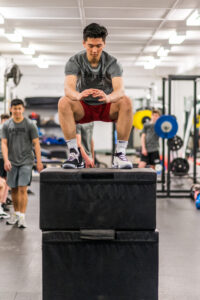BY SEAN DEL BEN, MKIN, CSCS, FMS LVL.2, FRC

Box jumps – why do we do them? I find that the box jump is one of the more misunderstood exercises. I have myself questioned what their purpose is and have heard many other coaches question them as well. Yet I have only stumbled across negatively biased articles which were focused solely on how dangerous they are. There was no mention of the benefits of box jumps. This brief article is meant to shed some light on why you would WANT to use box jumps. It will cover in which situations they will be no different than squat jumps performed solely on the floor. This short article will also cover safety measures to protect you and your athletes from injury.
WHEN TO USE BOX JUMPS
As with all exercises and tools (barbell, kettlebell, dumbbell, etc.), it is important to first determine what it is you are trying to accomplish. At this point, you will then decide what the best course of action will be to achieve this goal. Let’s break box jumps into two separate categories: single effort box jumps, and continuous box jumps (performed as a plyometric w/ minimal ground contact time)
HERE ARE SOME REASONS TO UTILIZE SINGLE EFFORT BOX JUMPS IN YOUR ROUTINE:
- You are injured and must avoid the ground reaction forces associated with landing
- You are managing fatigue/avoiding overtraining and, again, must avoid landing
- Box Jumps are more dynamic than a squat jump. This is because they require the athlete to explosively flex at the hips in order to safely land on top of the box
- You plan on standing up on top of the box and dropping off to land. Doing this will better develop your ability to decelerate compared to landing from the height your elongated legs attained in a basic squat jump
- It presents a challenge for the athlete, with new visible goals (higher box) to complete
- They are fun! Box jumps are a good way of turning training into a competition amongst the athletes. Friendly competition creates interest and passion for training
HERE ARE SOME REASONS TO UTILIZE CONTINUOUS BOX JUMPS IN YOUR ROUTINE:
- You need to develop reactive strength in your athletes. Reactive strength is a form of explosive strength. Reactive strength refers to the ability to get off the ground as fast as possible once making contact with it. This means that the exercise is performed as a plyometric. As such, only the mid-foot to big toe make contact with the floor, with the goal of getting off the ground as fast as possible. Please see this article on explosive training to learn the various derivatives of explosive strength.
- You don’t have enough equipment or space to perform multiple drop jumps with multiple boxes. Continuous box jumps are training reactive strength in the same manner as drop jumps would. Ensure the athlete has the required strength and training age to drop off the box in question.
HOW IS THE SINGLE EFFORT BOX JUMP DIFFERENT THAN A SQUAT JUMP?
There are multiple variables that must be considered to differentiate between box jump and squat jumps.
If we are talking about single effort box jumps, we must consider many variables, one of which is Center of Mass. Consider that when you perform a squat jump vs landing in an athletic ready position on top of a box during a box jump, your center of mass is actually the same as if you were performing a squat jump. Therefore, unless you are going to stand up on top of the box, and then step off and land, the force your body must absorb upon landing is the same.
It doesn’t matter if you are performing a basic squat jump, or if you are jumping up onto a box and lightly frog hopping off the box to get back to the ground. If you seek greater ground impact to develop the athletes’ ability to decelerate, make sure they stand up on top of the box prior to jumping back to the ground.
…WHAT ABOUT FOR THOSE REHABBING?
A single effort box jump is a great exercise for those who are rehabbing, or are monitoring fatigue levels. These athletes should not be exposing themselves to a high degree of ground impact. In the case of the injured or fatigued athlete, you should have your athlete jump onto the box, and use objects to step down safely to the floor.
Box jumps are fun and challenging! It is easier for an athlete to give full effort when they have no choice but to get on top of the box. If they don’t succeed, the athlete may topple over the boxes or scrape their shins (see safety measures below!). Starting a competition amongst a particular group of athletes can also be a good bonding experience, as well as generate excitement and passion for training.
HOW IS THE CONTINUOUS BOX JUMP SIMILAR TO A TUCK JUMP?
To realize the similarities between a continuous box jump and a tuck jump, remember the Center of Mass variable. In the continuous box jump, the athlete first jumps onto a box. Subsequently, they very quickly jump back down on the same side. Upon contact with the ground, the athlete explodes back up off the ground as fast as possible. In the tuck jump, the athlete first explodes off the ground and tucks their knees high towards the chest. Next, the athlete explosively drives their feet into the ground upon landing in order to get off the ground as fast as possible. In both exercises, the center of mass stays the same. Therefore eliminating any extra benefit from ground impact forces you may believe you are increasing/decreasing by adding/eliminating the box.
In order to increase the ground reaction force upon ground impact, you will have to first stand up on the box prior to stepping off. That or begin a depth jump from a greater height.
SAFETY MEASURES
It is very common to see pictures posted on social media of those who have attempted and failed a box jump. Do you care to save the skin on your shins when failing an attempt on an iron box? If so, it is necessary to seriously consider some safety precautions.
- Use foam/padded plyometric boxes if available
- Have a spotter behind the athlete, in front on the other side of the box, and on both the right and left of the athlete. This creates a safer environment and also helps mentally prepare the athlete to jump to a high box.
- If you are using aerobic steppers, or multiple smaller boxes as your platform, ensure that the spotters are holding the box steady as you start getting to the greater heights.
- If you are monitoring fatigue, or are dealing with a rehabbing athlete, have them step down safely off the box.
- Unless you attempt a personal record box jump, ensure the athlete lands in an athletic ready position with a neutral spine
